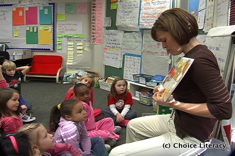As a reading teacher, I used to joke that it was important to spend time teaching fluency as a matter of sanity. That’s being a bit flip, but fluency is something to consider as we work with young readers. Fluency does matter. However, I’m thinking we need to dig a little deeper. Saying a student needs help with fluency is probably equivalent to saying my house needs cleaning. Having to pick up items and straighten rooms of the house is very different from needing to scour bathrooms and scrub floors.
There’s more to a fluency score than the score on a rubric.
There’s Gavin, who read every new book word by word. His comprehension scores demonstrated strength in understanding, but his accuracy scores told a different story. He had a hard time using visual information efficiently and seemed to overanalyze every word.
There’s Sophia. who read in long phrases and paused meaningfully at punctuation, but froze when she came to unknown words. She’d spend a lot of time looking at the word before deciding how to solve it. Although she had many reading strategies, she didn’t flexibly make adjustments when the reading was tricky. Her fluency score suffered from these long pauses. Her familiar reading and her reading of books at an independent reading level were always fluent.
There’s Molly, who lost track of meaning as she read. Her reading sounded word by word, and her comprehension responses demonstrated only a surface-level understanding of the text. In daily reading if you stopped her as she read to discuss the story, she often had to reread, look back, or think for some time to articulate meaning. Her reading of familiar text was much more fluent, and I noticed her fluency would improve as she got farther into the text.
All of these students have low fluency scores, but their struggles are in different places, so their support needs to look different in daily instruction.
Taking a Closer Look
Low fluency scores can’t always be solved by practicing repeated reading or using teaching strategies designed to quicken a student’s pace. The sound of the reading is only one piece of fluency and may mask other challenges the reader is facing. In working with readers needing extra support, I’ve learned that fluency can be something we need to spend time working to develop. I’ve also learned that building fluency isn’t just helping students read faster; it’s looking at their reading from a variety of different places and considering it in a multitude of contexts. Although I do consider what I learn from benchmark assessments, I also consider the following:
- familiar reading
- running records on familiar reading
- fluency in independent texts
- the amount of reading a child does
- the type of reading a child does
- the reader’s speech patterns
- the reader’s level of understanding of their reading
Considering observations of students alongside more formal assessment information widens my lens. Considering varying contexts helps me weigh the challenge of the concern and see missing links. When students are demonstrating lower fluency scores, here are some questions I like to consider:
- What has affected the fluency score?
- Is the student reading in phrases?
- What is the length of these phrases?
- Did the student read dialogue with fluency?
- Did the student pause at punctuation?
- Did the reader use meaningful expression?
- How did the student do with the comprehension discussion?
- Did fluency improve as the student was farther in the book?
- What was the accuracy of this book?
- Does the student stop to solve for long periods of time?
- Does the student read fluently in familiar books?
- Does the student read fluently in books just below his or her instructional level?
- Does the student read easy books with fluency?
A Multifaceted Approach
Instead of trying to improve the reading rate, my hope is to find the underlying difficulty that is causing the reader’s rate to slow, and work from there.
Gavin, who was reading word by word because of accuracy issues, needed to learn to more efficiently take apart words. Helping him to more efficiently use larger beginning chunks helped him work in balance with meaning once again. We worked outside of his reading in word learning, and brought these strategies into the books he was reading. During this time I alternated instructional-level texts with texts that were just a bit easier so he could more strategically do this visual work and get the feel of reading text more fluidly.
Sophia, who paused to wait at difficulty, needed to become more flexible in her strategies. We worked on rereading and reading on quickly when she came across tricky words. We had conversations about how as readers we sometimes have to try more than one thing when we are trying to figure something out. I looked for opportunities to celebrate the times she solved by using a variety of strategies. Her confidence improved, and so did her pace.
Molly, who was having difficulty reading for meaning, needed support in thinking about her story. We worked to develop her prereading strategies to bring her focus to the meaning of the text. She talked through her picture walks and asked questions about the author’s message before getting ready to read. We practiced finding places to stop and think about what was happening as she read. We began by placing sticky notes in places to pause, but then worked toward noticing those places in her reading independently. We put our focus on talk about the book, and she began to show improvement.
In all three of these cases, familiar reading, intentional book selection, and well-articulated goals were part of our plan. There’s no one-size-fits-all solution for building fluency, but a deeper look can give us new information to use in planning instruction. Developing readers is an art as much as it is a science. Staying balanced in our approaches can be a helpful first step.









